- Why is understanding pupils important for effective teaching?
- How can teachers create a safe and open classroom environment to foster trust among students?
- What strategies can teachers use to recognize and accommodate individual learning styles in the classroom?
- How does encouraging student voice and choice contribute to better teacher-student interactions and learning engagement?
- Why is communicating with families essential in understanding a pupil’s emotional and academic needs?
Introduction
Understanding pupils is one of the most important aspects of good teaching. Every student comes to the classroom with a distinct background, personality, set of skills, and learning style. When teachers truly understand their pupils, they may form meaningful connections that promote academic success, emotional well-being, and personal growth. Understanding students entails more than just knowing their names and recognizing their academic skills; it also entails understanding their experiences, emotions, and opinions. This article will give 7 key strategies for teachers to understand their children better.
Create an open and safe environment.
- Teachers should establish a safe and welcoming classroom atmosphere.
- Students must feel valued, respected, and safe to express themselves freely.
- Teachers can encourage this by setting classroom standards that value respect, active listening, and kindness.
- Teachers should enable pupils to share their views and ideas without fear of criticism to foster a sense of trust.
- When students trust their teacher, they are more willing to share their interests, difficulties, and goals.
Recognize individual learning styles.

- Teachers should recognize individual learning styles to gain an understanding of their needs. Not all students learn in the same way: some are visual learners, while others are auditory or kinesthetic learners.
- Teachers who alter their teaching approaches to accommodate diverse learning styles not only make lessons more accessible but also demonstrate that their students’ needs are being met.
- Teachers can use informal assessments, class observations, and student conversations to identify how each student absorbs knowledge most effectively.
Establish personal connections.
- Teachers can make a personal connection for creating meaningful interactions. They should know their students beyond the classroom by inquiring about their hobbies, backgrounds, and family situations.
- These personal connections allow teachers to better understand what inspires their students, what they care about, and how they process emotions.
Observe behaviour and emotions.
- Teachers can observe their students’ emotional well-being by assessing their behaviours and facial expressions.
- Body language like slumped shoulders, fidgeting, or lack of eye contact signals anxiety, sadness, or discomfort.
- Facial expressions such as furrowed brows, forced smiles, or watery eyes can denote emotional struggles. How engaged the students are in the class—whether they participate actively, remain silent, or seem distracted—would also acknowledge their mental and emotional conditions.
- All these subtle cues would be noted by the teacher, after which someone may be given the necessary attention he or she needs.
Encourage student voice and choice.

- Teachers should allow pupils to participate in their learning to better understand them. Student voice and choice empower students by allowing them to express their choices and actively participate in classroom decision-making.
- Teachers might solicit students’ feedback on themes of interest, project options, or even classroom rules. This improves the teacher-student interaction and instils a sense of ownership in students. It leads to enhanced motivation and engagement.
Use formative assessments to gather insight
- Nevertheless, formative assessments are informal yet potent instruments that can help teachers assess what their students know and how much those students are progressing in their learning.
- Such assessments involve quizzes, class discussions, exit tickets, peer feedback, and short reflections, and they allow teachers to collect instantaneous feedback about their students.
- Through analyzing their students’ responses, teachers can fairly establish where knowledge gaps or misconceptions lie, as well as what might need extra encouragement.
- Formative assessments push teachers to constantly amend and improve their ways since they differ from summative tests that assess overall performance.
- Formative assessments have the added benefit of high participation, the means to instil confidence, and thereby create a growth mindset. The regular use of formative assessments assures that learning becomes a personalized and hence efficient affair.
Communicate with families.
- A student’s family environment profoundly affects academic achievement, behaviour, and emotional health.
- Communication allows the teacher to know more about a student’s weaknesses, strengths, and general development. Parent-teacher conferences afford the chance for discussions on progress, concerns, and strategies for improvement.
- Phone calls and emails create an easy way to provide updates, offer support, and develop a solid parent-teacher relationship.
- Working together creates consistency in encouragement for a child, establishing a conducive environment for learning.
- Communication allows teachers to meet the individual needs of students in a better way and prepares education for success.
Conclusion
It is essential to establish meaningful relationships with students as the primary constituent to promoting meaningful learning outcomes in students. Through developing the conditions that support such relations, understanding that children learn in different ways, and establishing relationships Personal classroom management was beneficial in understanding students’ needs and helping them teachers. Recording student behaviour, empowering students to make decisions, incorporating quizzes and checks, and communicating with families provide more information about students’ lives. The above practices promote students’ rights, enhance their self-esteem and foster a conducive environment for learning. However, if teachers can be of utmost to the students, they effectively convey knowledge and at the same time, develop the true potential of a man to produce sound citizens ready to face future challenges.
You may like to read:-
UNESCO Report: The Impact of Climate Change on Education
Educational Leadership: Building a Better Tomorrow
- How to Dominate Your Online Business With 5 Proven Digital Marketing Strategies
- How to Cultivate Critical Thinking and Problem-Solving Skills in Classroom
- Top Proven Mental Health Strategies for Schools in 2025-26
- Time Management for Teachers: How to Plan, Prioritize, and Perform Better
- How Parental Involvement in Education Shapes a Child’s Growth and Success
FAQs
1. Why is understanding students important for teachers?
Teachers can ensure that trust them and develop appropriate teaching strategies for everyone that result in improved academic and emotional performance.
2. How can teachers identify individual learning styles?
Teachers can take simple tests and quizzes and listen to testimonies from learners in order to know if they are visual, auditory or kinesthetic learners.
3. What are some ways to create a safe classroom environment?
Teach acceptable behaviour regarding each other, get a commitment to non-aggressive verbal and written communication and provide an environment where all students’ ideas are welcome without negative remarks.
4. How does student voice and choice improve engagement?
Teachers should offer choices to students such as choice of project topics or deems to provide the students with a natural motivation to learn, or a feeling of being involved in the process of learning.
5. How can teachers build stronger connections with students?
Teachers can get to know the students and their interests, origin, and family situations, thus knowing what encourages students and develops rapport.



